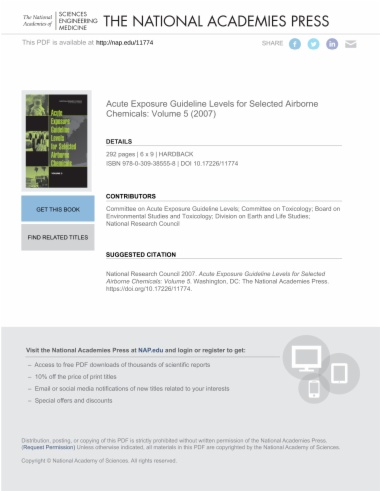

In 1993, the National Research Council's Committee on Toxicology developed criteria and methods for EPA and the Agency for Toxic Substances and Disease Registry (ATSDR) to develop community emergency exposure levels for extremely hazardous substances for the general population. A few years later, the National Advisory Committee for Acute Exposure Guideline Levels for Hazardous Substances (NAC)—composed of members of EPA, DOD, other federal and state agencies, industry, academia, and other organizations—was established to identify, review, and interpret toxicologic and other scientific data to develop acute exposure guidelines (AEGLs) for high-priority, acutely toxic chemicals. Three levels—AEGL-1, AEGL-2, and AEGL-3 are developed for each of five exposure periods (10 min, 30 min, 1 hr, 4 hr, and 8 hr) and are distinguished by varying degrees of severity of toxic effects. This current report reviews the NAC reports for their scientific validity, completeness, and consistency with the NRC guideline reports developed in 1993 and 2001. This report is the fifth volume in the series and covers AEGLs for chlorine dioxide, chlorine trifluoride, cyclohexylamine, ethylenediamine, hydrofluoroether-7100, and tetranitromethane. It concludes that the AEGLs developed by NAC are scientifically valid and consistent with the NRC guideline reports. AEGLs are needed for a wide range of planning, response, and prevention applications. These values provide data critical to evacuation decisions and discussions between community leaders and industries as they seek ways to minimize the health impact should the chemical release occur. Some of the finalized AEGLs have been officially adopted by the Department of the Army, FEMA, and the Department of Transportation as the official levels for use by those agencies.